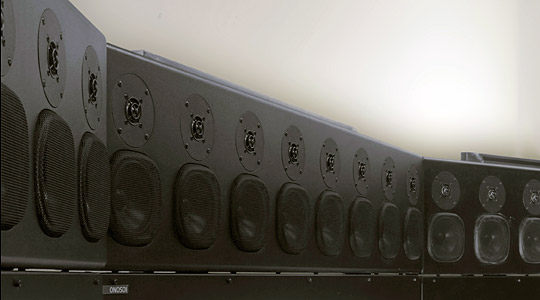Pulse Lab II
Works for Wave Field Synthesis

Pulse Lab II – Works for Wave Field Synthesis is the second collaboration between the Sound Studies department of the Berlin University of Arts and CTM. This time it is all about the distribution of sound in space, utilizing a ring of 192 computer controlled loudspeakers. This technique is called wave field synthesis (WFS) and allows one to place a huge number of virtual sound sources anywhere inside and outside that ring.
Most spectacular is the effect of locating a sound source inside one's own head, an experience that cannot be achieved using other techniques. The large number of speakers is the equivalent to a large number of pixels in the visual world, enabling subtle and precise placements in space and a impossible depth of field. Wave field synthesis is a new technique that relies on powerful computers and on advanced algorithms for calculating the signals going to each speaker.
The ability to explore such a system solely for artistic purposes is still quite rare. Due to the generous support by the Fraunhofer IDMT and IOSONO GmBH, Sound Studies is able to figure out what can be done with such a beast. First results of this artistic research will be presented at Pulse Lab II, works by students as well as pieces by professor Robert Henke, who is supervising the system and curates the installation for CTM. The contributions may be quite diverse, ranging from quiet, intimate studies of movement, to roaring storms of particles, that go straight through your head and brain, or interactive audiovisual works.
The WFS system is located in the middle of the HAU2's rehearsal stage, allowing visitors to walk around and experience the auditive equivalent to 3D cinema. During the course of the exhibition the pieces run as a loop, and students will be present and happy to answer technical questions or engage in discussions about artistic implications.
The soundstudies WFS system is kindly supported by IOSONO, Fraunhofer IDMT, Cycling74, Ableton and Imbalance Computer Music.


